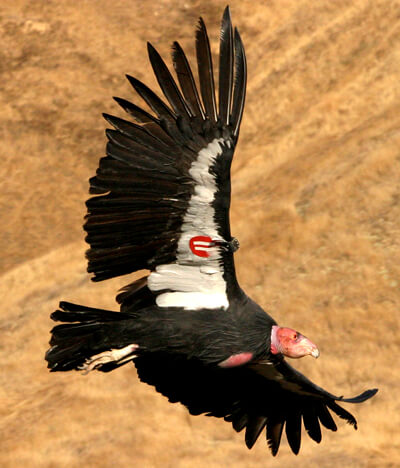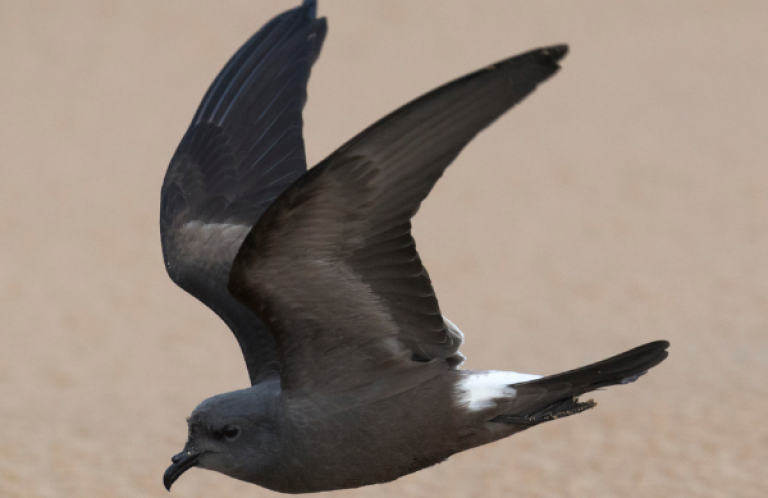New Study Says Lead Ammunition Thwarting Condor Recovery Efforts
 |
| California Condor, USFWS |
(July 10, 2012) A new study led by environmental toxicologists at the University of California, Santa Cruz, shows that California Condors are continually exposed to harmful levels of lead, that the principal source of the lead is spent ammunition, and that it is preventing the full recovery of the condor population.
The scientists reported their findings in a paper published this week in the Proceedings of the National Academy of Sciences (PNAS). First author Myra Finkelstein, a research toxicologist at UC Santa Cruz (UCSC), said the study shows that without a solution to the problem of lead poisoning, the condor population can only be sustained through intensive and costly ongoing management efforts.
"We will never have a self-sustaining wild condor population if we don't solve this problem," she said. "Currently, California Condors are tagged and monitored, trapped twice a year for blood tests, and when necessary treated for lead poisoning in veterinary hospitals, and they still die from lead poisoning on a regular basis."
With a total population of just 22 birds in 1982, the California Condor once teetered on the brink of extinction. A successful captive breeding program enabled the reintroduction of condors into the wild (at sites in California, Arizona, and Baja California, Mexico), and the total population grew to nearly 400 birds (captive and free-flying) by the end of 2010. But the new study, which focuses on condors in California, describes a population still on the verge of collapse, sustained only by ongoing human intervention.
Since 1997, about half of all free-flying condors in California have required treatment for lead poisoning, and each year, about one in five birds needs treatment. This usually involves capturing the birds and transporting them to a zoo where they can receive special “chelation” therapy to remove lead from their blood, followed by supportive care until they are healthy enough to return to the wild.
Condors are opportunistic scavengers, feeding primarily on the carcasses and gut-piles of deer and elk. They often ingest lead bullet fragments from traditional ammunition when feeding on the remains of animals shot by hunters. Lead poisoning was probably one of several factors that led to the near extinction of the species. A previous study had already identified ammunition as the principal source of lead poisoning in condors. The new study confirms and extends the earlier findings that lead poisoning is a limiting factor to full recovery of the species.
The UCSC researchers were able to identify the source of the lead in condor blood samples using a "fingerprinting" technique based on the unique isotope ratios found in different sources of lead. Condors raised in captivity that have not yet been released into the wild have low blood lead levels, with lead isotope ratios that fall within the range of background environmental lead in California. Most free-flying condors, however, have lead isotope ratios consistent with those found in ammunition. The higher a bird's blood lead level, the more likely that its lead isotope ratio matches the lead in ammunition.
In addition to blood samples, the researchers also analyzed lead in feathers. Because feathers grow over a period of several months, sampling sequentially along the length of the feather gives a history of the bird's lead exposure.
“The results not only show that condors are chronically lead poisoned, but also suggest that the magnitude of lead exposure is likely much higher than indicated by periodic blood monitoring,” Finkelstein said. The reason for this conclusion is that blood lead levels spike 2-3 weeks after exposure and then decline as the lead moves into other organs in the body (e.g., liver, kidney, brain).
“This research constitutes another very credible scientific study on how lead ammunition is poisoning wildlife. Hunters have a proud conservationist tradition, and through the purchase of permits, stamps, and excise taxes, have helped pay for a wide range of habitat protection and professional wildlife management efforts. It's now time for hunters and their friends live up to that history by converting to non-lead ammunition and once again be a positive force in our precious natural resource heritage,” said John Schulz, non-lead campaign manager for American Bird Conservancy, a leading bird conservation group who supports the use of non-lead ammunition.
The condor program currently costs about $5 million per year, including the contributions of all the agencies and organizations involved in the effort. This level of management would have to continue in perpetuity to keep the population from extinction.
In 2008, a regulation was enacted in the southern California condor range banning the use of traditional lead-based ammunition. However, condors can travel hundreds of miles in a single day and do not recognize state boundaries, thus necessitating a broader approach to solving the problem. Arizona has adopted a voluntary non-lead ammunition program in the northern portion of the state, and has provided hunters with either free non-lead ammunition or coupons for reduced cost ammunition. Utah has a similar program, but it is currently not funded.
"Unfortunately, even if only a few people are still using lead ammunition, there will be enough contaminated carcasses to cause lead poisoning in a significant number of condors," Finkelstein said. "We found that over the course of ten years, if just one half of one percent of carcasses have lead in them, the probability that each free-flying condor will be exposed is 85 to 98 percent, and one exposure event could kill a condor."
In addition to Finkelstein, other co-authors of the study include: Dan Doak, University of Colorado biologist; Donald Smith, Professor of Environmental Toxicology at UCSC; Jesse Grantham, who recently retired as head of the Condor Recovery Program for the U.S. Fish and Wildlife Service; Daniel George, Condor Program Manager at Pinnacles National Monument; Joe Burnett of the Ventana Wildlife Society; Joseph Brandt of the U.S. Fish and Wildlife Service; and Molly Church of the San Diego Zoo's Wildlife Disease Laboratories. This research was supported by the National Park Service, Western National Park Association, and the U.S. Fish and Wildlife Service.


















































